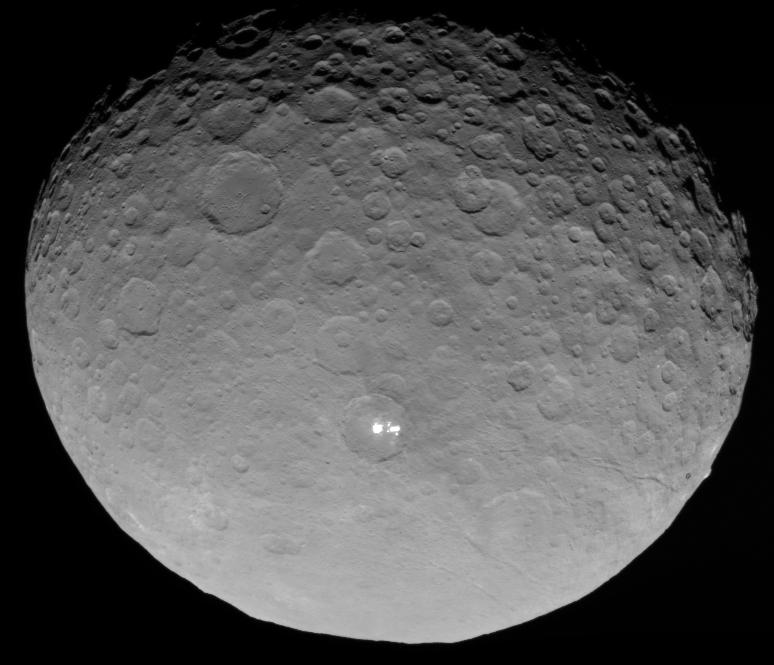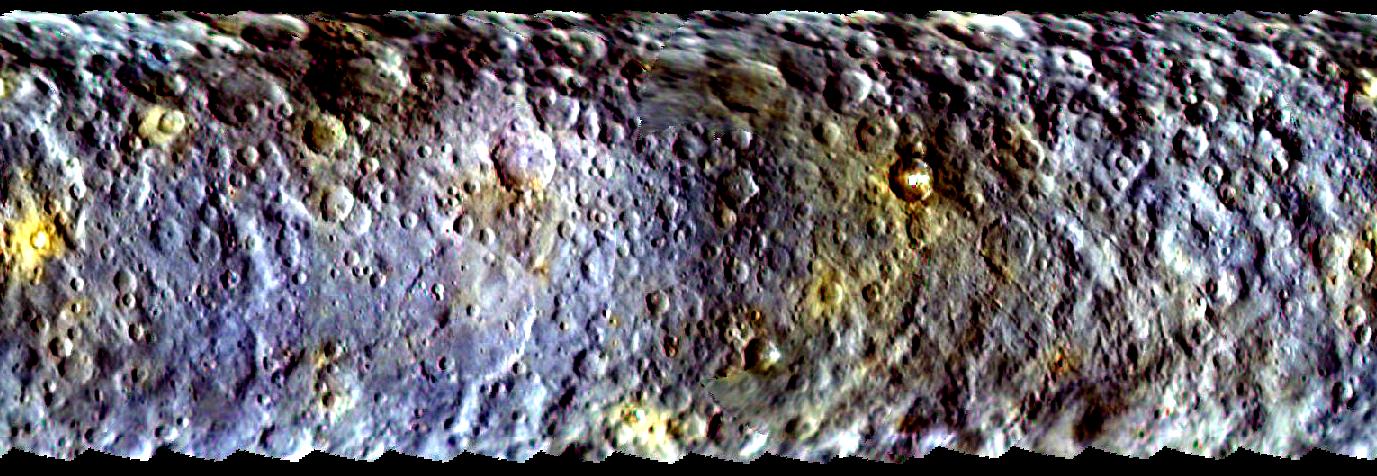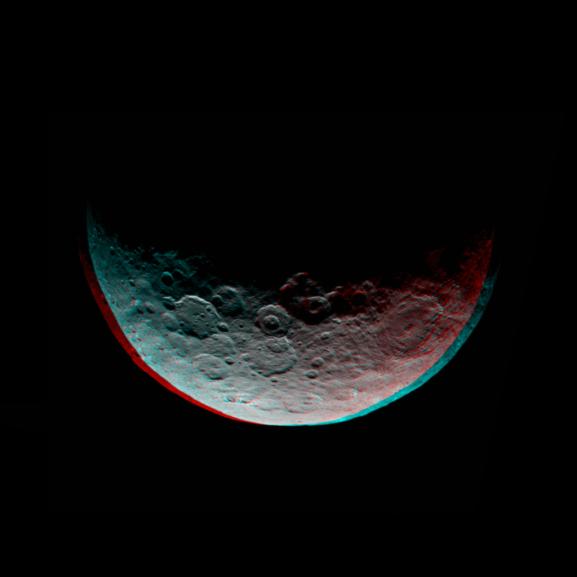Page 4 of 8
Re: Dawn: Journey to the Asteroid Belt
Posted: Sun Mar 08, 2015 5:43 pm
by alter-ego
BDanielMayfield wrote:THX1138 wrote:I'm not understanding why pictures were available all the way up until Dawn was close enough to see the rock up close, in orbit. Now that its close enough to see what the bright spots are................We have to wait????
Just listened to the press conference Rob linked to and the real reason they kept giving for the delay in new photos coming out is that Dawn is now orbiting on the "dark side" of Ceres. The higher the orbit and the lower the mass of the body being orbited, the slower the orbit. Dawn will be over the sunlit side of Ceres in April.
To add to Bruce's comment, here's a snippet from a mid-February article:
AmericaSpace wrote:And because of the angle of the approach trajectory, Ceres will not be very illuminated until the end of April when Dawn reaches its initial science altitude orbit of about 8,400 miles (13,500 kilometers).
Dawn’s next imaging session is scheduled for early March, but likely won’t reveal much more.
“The next images will be a little bit better. But the resolution doesn’t get much better until late April!” Russell explained.
Re: Dawn: Journey to the Asteroid Belt
Posted: Tue Mar 10, 2015 3:30 am
by THX1138
Thanks all i understand the situation fully now
As the white spots go, were I a conspiracy type person ( which i am certainly not ) I'd have thrown the book at this one.
Imagine they are all up in arms over over this ???
Think I'll google it to find out just for a laugh right now
CYA and thanks again all
Re: Dawn: Journey to the Asteroid Belt
Posted: Tue Apr 07, 2015 2:49 pm
by bystander
Re: Dawn: Journey to the Asteroid Belt
Posted: Wed Apr 08, 2015 5:15 am
by THX1138
Thanx bystander
Re: Dawn: Journey to the Asteroid Belt
Posted: Wed Apr 08, 2015 5:20 am
by BMAONE23
Looking forward to April 15 and beyond
Dawn's Ceres Color Map Reveals Surface Diversity
Posted: Mon Apr 13, 2015 5:01 pm
by bystander
Dawn's Ceres Color Map Reveals Surface Diversity
NASA |
JPL-Caltech | Dawn | 2015 Apr 13
A new color map of dwarf planet Ceres, which NASA's Dawn spacecraft has been orbiting since March, reveals the diversity of the surface of this planetary body. Differences in morphology and color across the surface suggest Ceres was once an active body, Dawn researchers said today at the 2015 General Assembly of the European Geosciences Union in Vienna. ...
Ceres' surface is heavily cratered, as expected, but appears to have fewer large craters than scientists anticipated. It also has a pair of very bright neighboring spots in its northern hemisphere. More detail will emerge after the spacecraft begins its first intensive science phase on April 23, from a distance of 8,400 miles (13,500 kilometers) from the surface, said Martin Hoffmann, investigator on the Dawn framing camera team, based at the Max Planck Institute for Solar System Research, Göttingen, Germany.
The visible and infrared mapping spectrometer (VIR), an imaging spectrometer that examines Ceres in visible and infrared light, has been examining the relative temperatures of features on Ceres' surface. Preliminary examination suggests that different bright regions on Ceres' surface behave differently, said Federico Tosi, investigator from the VIR instrument team at the Institute for Space Astrophysics and Planetology, and the Italian National Institute for Astrophysics, Rome. ...
Mystery of Ceres' bright spots grows
Nature News | 2015 Apr 13
Re: Dawn's Ceres Color Map Reveals Surface Diversity
Posted: Wed Apr 15, 2015 4:33 am
by alter-ego
The false color scheme was interestingly intentional:
Dawn Maps Ceres in False Color (S&T, Camille M. Carlisle) wrote:The color scheme in this map is inverted from reality: the version JPL released assigns the short, bluer wavelengths to be red, and the long, infrared wavelengths (which the human eye can't see) to be blue. That seemed a wee daffy to me, so I asked what was up. Turns out the camera team wanted the map to look unreal: it's too early in the mission to unambiguously separate all the things that influence the surface's apparent color, and when the team made a map with a different color scheme, it led to misleading interpretations even among the team's own members. So instead they decided to emphasize the "false" in false-color and forestall confusion.
Re: Dawn: Journey to the Asteroid Belt
Posted: Wed Apr 15, 2015 10:52 am
by geckzilla
Here is the image uninverted. Is it because blue makes people think of ice?
Re: Dawn: Journey to the Asteroid Belt
Posted: Wed Apr 15, 2015 2:04 pm
by Chris Peterson
geckzilla wrote:Here is the image uninverted. Is it because blue makes people think of ice?
I think there's a lot of value to selecting false color schemes that shift images from anything approaching "natural" colors (not just with planetary images, but also deep sky images, where I frequently prefer to avoid seeing efforts at "real" color). Your observation about ice may or may not be accurate, but it illustrates the point that we do try to interpret images according to certain expectations, and when there's a good chance those expectations may be far from reality it's useful to break them completely.
JPL: Dawn Glimpses Ceres' North Pole
Posted: Fri Apr 17, 2015 7:02 pm
by bystander
Dawn Glimpses Ceres' North Pole
NASA | JPL-Caltech | Dawn | 2015 Apr 16
[img3="This animation shows the north pole of dwarf planet Ceres as seen
by Dawn on April 10, 2015. Dawn was at a distance of 21,000 miles
(33,000 kilometers) when its framing camera took these images.
Credit: NASA/JPL-Caltech/UCLA/MPS/DLR/IDA"]http://www.jpl.nasa.gov/images/dawn/201 ... 317-16.gif[/img3]
After spending more than a month in orbit on the dark side of dwarf planet Ceres, NASA's Dawn spacecraft has captured several views of the sunlit north pole of this intriguing world. These images were taken on April 10 from a distance of 21,000 miles (33,000 kilometers), and they represent the highest-resolution views of Ceres to date.
Subsequent images of Ceres will show surface features at increasingly better resolution.
Dawn arrived at Ceres on March 6, marking the first time a spacecraft has orbited a dwarf planet. Previously, the spacecraft explored giant asteroid Vesta for 14 months from 2011 to 2012. Dawn has the distinction of being the only spacecraft to orbit two extraterrestrial targets.
Ceres, with an average diameter of about 590 miles (950 kilometers), is the largest body in the main asteroid belt between Mars and Jupiter. Dawn has been using its ion propulsion system to maneuver to its first science orbit at Ceres, which it will reach on April 23. The spacecraft will remain at a distance of 8,400 miles (13,500 kilometers) from the dwarf planet until May 9. Afterward, it will make its way to lower orbits.
Re: Dawn: Journey to the Asteroid Belt
Posted: Mon Apr 20, 2015 9:11 pm
by BMAONE23
Re: Dawn: Journey to the Asteroid Belt
Posted: Mon May 04, 2015 1:12 pm
by neufer
http://photojournal.jpl.nasa.gov/catalog/PIA19320 wrote:
This anaglyph of Ceres is part of a sequence of images taken by NASA's Dawn spacecraft April 24 to 26, 2015, from a distance of 8,500 miles (13,500 kilometers). This shows the same view as PIA19319.
Re: Dawn: Journey to the Asteroid Belt
Posted: Thu May 07, 2015 8:59 am
by THX1138
YouTube / Ceres bright spots / Not very happy with the pictures (All Blurry) That NASA keeps releasing
That's all I'm going to say
JPL: Ceres Animation Showcases Bright Spots
Posted: Mon May 11, 2015 4:51 pm
by bystander
Ceres Animation Showcases Bright Spots
NASA |
JPL-Caltech |
Dawn | 2015 May 11
[c]
Click on the image for the animation
Credit: NASA/JPL-Caltech/UCLA/MPS/DLR/IDA[/c]
The mysterious bright spots on the dwarf planet Ceres are better resolved in a new sequence of images taken by NASA's Dawn spacecraft on May 3 and 4, 2015. The images were taken from a distance of 8,400 miles (13,600 kilometers). ...
In this closest-yet view, the brightest spots within a crater in the northern hemisphere are revealed to be composed of many smaller spots. However, their exact nature remains unknown.
"Dawn scientists can now conclude that the intense brightness of these spots is due to the reflection of sunlight by highly reflective material on the surface, possibly ice," said Christopher Russell, principal investigator for the Dawn mission from the University of California, Los Angeles.
These images offer scientists new insights into crater shapes and sizes, and a host of other intriguing geological features on the surface. The image resolution is 0.8 mile (1.3 kilometers) per pixel. ...
Re: Dawn: Journey to the Asteroid Belt
Posted: Thu May 14, 2015 8:17 am
by BMAONE23
THX1138 wrote:YouTube / Ceres bright spots / Not very happy with the pictures (All Blurry) That NASA keeps releasing
That's all I'm going to say
Nothing seems blurry about the image above
Re: Dawn: Journey to the Asteroid Belt
Posted: Thu May 14, 2015 9:15 am
by geckzilla
None of them have been blurry. They've just been relatively low resolution, so people have been enlarging the images and by doing that it makes them look blurry. Dawn just isn't close enough yet to get those nice close up images.
Re: Dawn: Journey to the Asteroid Belt
Posted: Sat May 16, 2015 3:35 pm
by THX1138

- Over Magnification, that's the problem ?
- cerial.jpg (3.81 KiB) Viewed 53194 times
Re: Dawn: Journey to the Asteroid Belt
Posted: Sat May 16, 2015 5:41 pm
by geckzilla
It's not magnification. Magnification is done by lenses. The method of enlarging and interpolating the data digitally is sometimes called magnification because it seems analogous to a real life magnifying glass, but rather than redirecting the light to make the object bigger and details easier to see, digital enlargement has to use interpolation, which just guesses new data into existence. It doesn't actually reveal more detail and has the effect of making the object look blurry. The image you posted was probably originally half that size.
Re: Dawn: Journey to the Asteroid Belt
Posted: Sat May 16, 2015 6:15 pm
by Chris Peterson
geckzilla wrote:It's not magnification. Magnification is done by lenses.
The technical term for this sort of "over magnification" is "undersampling".
Re: Dawn: Journey to the Asteroid Belt
Posted: Mon May 18, 2015 8:16 pm
by Ron-Astro Pharmacist
Chris Peterson wrote:geckzilla wrote:It's not magnification. Magnification is done by lenses.
The technical term for this sort of "over magnification" is "undersampling".
Doesn't some magnification come from the primary objective mirror or lens? When I attach my camera to my 4 inch reflector the view is quite magnified without a lens. Is it just "most" of the magnification come from the lenses?
Optics – not my bailiwick.

Re: Dawn: Journey to the Asteroid Belt
Posted: Mon May 18, 2015 9:00 pm
by Chris Peterson
Ron-Astro Pharmacist wrote:Chris Peterson wrote:geckzilla wrote:It's not magnification. Magnification is done by lenses.
The technical term for this sort of "over magnification" is "undersampling".
Doesn't some magnification come from the primary objective mirror or lens? When I attach my camera to my 4 inch reflector the view is quite magnified without a lens.
Actually, if you attach your camera to the back of your telescope, that optical system isn't even a telescope anymore by the definitions of optics. A telescope is an
afocal system: it has an objective and an ocular (eyepiece), and doesn't have any focal plane at all. A collimated input produces a collimated output, and the optical system depends on your eye for focus. The magnification of the system is defined as the focal length of the objective divided by the focal length of the ocular. That value is physically meaningful, in the sense that it means that you actually see the target at (magnification) times larger than you would with the naked eye.
When you simply place an image sensor at the focal plane of an objective, you have a
focal optical system. You can't see anything with your eye. A collimated input produces an image at the focal plane of the objective, located behind it at a distance specified by its focal length. Magnification isn't well defined, and has little physical meaning. These optical systems are better called "cameras" than "telescopes", and that includes the HST.
Re: Dawn: Journey to the Asteroid Belt
Posted: Tue May 19, 2015 12:31 am
by Nitpicker
To add to what Chris has said, a simple way to think of the magnification of an afocal system (like a telescope with eyepiece), is apparent field of view divided by actual field of view. But this same definition cannot be applied to a focal system (like a camera with a telephoto lens), as the apparent field of view of an image on an image plane, depends on how the image is displayed and one's distance from it. (In other words, are you holding the image up to your nose, or is it hanging on the wall at the other side of the room?)
In the case of both afocal and focal systems, the lenses and/or curved mirrors, bend and focus the incoming light in their own ways. But in an afocal system, the focal plane is in clear space before the eyepiece. In a focal system, the image plane (typically the camera sensor) is placed at the focal plane.
The power of an afocal system is perhaps best described by its magnification, whereas the power of a focal system is best described by its focal length. (Where the term "power" is used without reference to light gathering capability.)
For a focal system with a focal length of F, focused on a distant object with an angular diameter alpha, the object appears at the focal plane with a linear diameter which can be stated simply as: F*tan(alpha), or even more simply as F*alpha, assuming alpha is expressed in radians and is no bigger than half a dozen angular Moon diameters (pi/60), say.
Re: Dawn: Journey to the Asteroid Belt
Posted: Wed May 20, 2015 7:50 pm
by Ron-Astro Pharmacist
Wow. Now I know it's not my bailiwick but I think I understand a little of what you're saying. The focal length dictated by the tube length divided by the focal length of the eyepiece (or camera adaptor) is the magnification the eye can sense if it's in correct harmony with the eye lens vs retina focal length.
Hopefully I'm getting closer and I do appreciate the insight. This sentence from Wiki's "Optical telescope" under Magnification makes me realize it's not an easy topic to get straight.
"Magnification is often misleading as the optical power of the telescope; its characteristic is the most misunderstood term used to describe the observable world."
Re: Dawn: Journey to the Asteroid Belt
Posted: Wed May 20, 2015 11:09 pm
by Chris Peterson
Ron-Astro Pharmacist wrote:Wow. Now I know it's not my bailiwick but I think I understand a little of what you're saying. The focal length dictated by the tube length divided by the focal length of the eyepiece (or camera adaptor) is the magnification the eye can sense if it's in correct harmony with the eye lens vs retina focal length.
It's the focal length of the
objective divided by the focal length of the eyepiece. The tube length isn't involved. In simple designs, the tube length is often similar to the focal length of the objective, but may be quite different.
The magnification isn't related to the optics of your eye. When a telescope is properly focused, your eye is operating exactly the same as when viewing an object at infinity. So the details of the eye don't matter. Look at the Moon, it creates an image of a certain size on your retina. Look at it through a 10X telescope, it creates an image on your retina exactly ten times larger.
Re: Dawn: Journey to the Asteroid Belt
Posted: Thu May 21, 2015 3:49 am
by Nitpicker
I wish I hadn't used the term "power" in my earlier post, as it can be very confusing.
A 100x magnification can also be referred to correctly as 100x power.
But a lens or mirror with a focal length, F, has an optical power (or dioptric power) of 1/F. So, the longer the focal length, the lower the optical power, but the larger the image at the focal plane.
And a telescope has a light gathering power proportional to the area (or diameter squared) of the objective.



